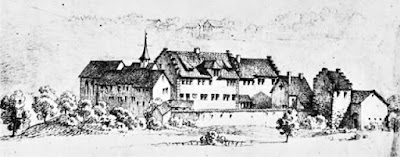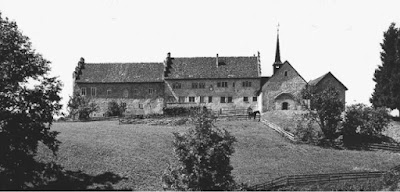In the village of Kilteel six miles north of Naas at the foot of the Wicklow mountains is Kilteel Castle.
It was built in the early thirteenth century by Maurice Fitzgerald for the Knights Hospitallers of St. John of Jerusalem. The site upon which the castle was built was once a monastic settlement.
It's most notable resident was Sir John Rawson who was the last Prior of the Kilmainham house of the Order before King Henry VIII dissolved the Order.
In 1511 he was appointed Prior of Kilmainham; this was a position of considerable political power, entitling him to sit both in the Irish House of Lords and on the Privy Council of Ireland. In 1517 he became Lord Treasurer of Ireland.
During the second siege of Rhodes in 1522 Sir John was the only knight from Ireland that responded to the Grand Master's request for knights to come to defend Rhodes. After the Siege, Rawson returned to Ireland where he continued to serve as Prior.
When Henry VIII decided to dissolve the Order of St. John of Jerusalem, and after lengthy negotiations Rawson in 1541 surrendered the Priory of Kilmainham in return for a payment of 500 marks and the title of Viscount Clontarf and the lease of the castle was given to Thomas Alen and his wife.
In 1669 Col. Richard Talbot, Earl of Tyreconnell became the owner of Kilteel. He then sold the castle to Sir William Fownes of Kilkenny where it remained in his family until 1838 when it was sold to the Kennedys of Johnstown-Kennedy.
Today the castle is a designated National Monument. It consists of a tower house dated to the fifteenth century, another projecting towerhouse with a spiral stairs and two further rooms at the gate-way.
"Per signum S. Crucis de inimicis nostris libera nos Deus noster Jesus, Crux, et Maria sint nihi salus, custodia ex via".
09 August 2016
08 August 2016
Knights at the Watch Tower Send Warning of the Invasion of Rhodes
Watch towers have sent out the alert! Invasion has started. Cavalry scouting the coast for the landing area. 40,000 troops are disembarking...where are we? Journeys of Faith, Culture & History...September 2017. Check out the new MedSeas website for more info
Mandraki Harbor Rhodes
The Mandraki was the military harbour and was guarded by a tower built between 1464 and 1467 by the Grand Master Zacosta. After the first Turkish siege of Rhodes in 1480 and the successful defense by the Knights of St. John, the Grand Master d'Aubusson added a bastion around the tower transforming it into a guard fortress on the sea.
Knights at the Watch Tower Send Warning of the Invasion of Rhodes
Watch towers have sent out the alert! Invasion has started. Cavalry scouting the coast for the landing area. 40,000 troops are disembarking...where are we? Journeys of Faith, Culture & History...September 2017. Check out the new MedSeas website for more info
05 August 2016
Knights Hospitaller Commandery of Bubicon, Switzerland
According to the inscription in the mural painting of the benefactors in the chapel, Count Diethelm V. of Toggenburg bequeaths the commandery of Bubikon to the Knights Hospitaller in Jerusalem circa 1192.
In 1215 there was a dispute over the land donated to the commandery between the noble families of Rapperswil and Toggenburg comes to an end with the joint re-foundation of the commandery by both families, captured by the painting of the benefactors.
In 1428 the revenues of the Commandery are transferred to the Grand Priory of Germany which was at that time headquartered in Heitersheim.
Knights of Malta Commandery of Bubikon around 1750. It was sold to a private citizen in 1789. More historical detail can be found at the Ritterhaus Bubikon website.




In 1215 there was a dispute over the land donated to the commandery between the noble families of Rapperswil and Toggenburg comes to an end with the joint re-foundation of the commandery by both families, captured by the painting of the benefactors.
In 1428 the revenues of the Commandery are transferred to the Grand Priory of Germany which was at that time headquartered in Heitersheim.
Knights of Malta Commandery of Bubikon around 1750. It was sold to a private citizen in 1789. More historical detail can be found at the Ritterhaus Bubikon website.

In 1938 plans for renovation of the property began and continued until 2011 when it was finally completed. In 1960 the first phase was complete and the property was placed under protection of the Swiss government.



04 August 2016
Two Knights of St John with Rabies Cured by the Blessed Virgin
From the Cantina CSM 275 of the Cantigas de Santa Maria of Alfonso X
Two Hospitaller friars of the convent of Moura [Spain] were stricken with rabies. They raged and clutched one at another and anyone else they could grab.
To subdue them the people tied them securely with a very strong rope. Then, hoping that the Virgin would cure them, they took them to Terena.
They lead them with difficulty, for they were snapping like dogs. They took them across the Guadiana River and entered Portugal.
As the first friar reached the top of the hill, he looked around and saw Terena, nestling in the valley up ahead. He asked to be released and said that he could see the Virgin and was sure that he had cured her of rabies.
He asked for a drink of water. The other friar said the very same thing when he saw the church. He also felt himself cured of rabies and they gave him a drink of spring water.
After they had finished drinking, they set off at once for Terena to fulfil their pilgrimage. They each offered the Virgin gifts and lit long candles, which they placed before the Virgin’s altar.
Subscribe to:
Posts (Atom)
Disclaimer
This blog and the opinions are all my own and in no way imply the endorsement from any organization. Nor does a recommendation of another blog or web site imply my agreement or endorsement of everything found on their site.




